Make the Most of Your Time Alone with Others
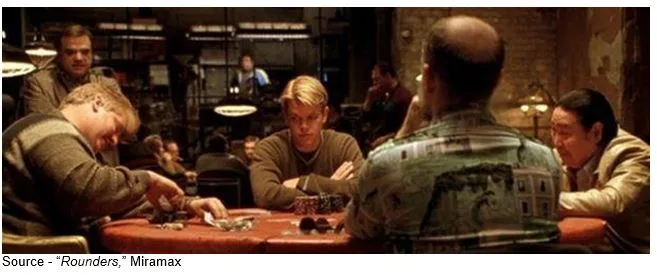
Every Friday afternoon for nearly 15 years we’d put the office in the rearview mirror, go to the boat, and sail San Francisco Bay or up/down the coast for the weekend.
The kids were forced to be with my wife and I and we with them.
But it gave each of us something really precious … alone time together.
We were all on the boat together, but we were each having totally different experiences.
How does that compare with your alone/together time online, with social media, your electronic devices; and increasingly, your streaming entertainment?
It doesn’t.
Not Sorry!
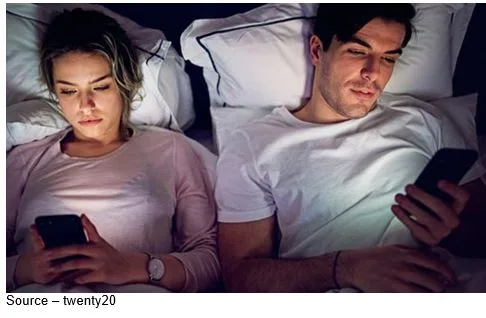
Several years ago, Internet.org (a social media networking services company partnership) was founded on the concept that “no one should have to choose between access to the internet and food or medicine.”
Sorry dudes/dudettes, we just don’t buy the idea that internet access is the same as life or death.
In fact, a ton of research organizations like Pew Research, Common Sense Media and others have come to the same conclusion — the large amount of time people spend online is leading to declines in happiness and increased loneliness.
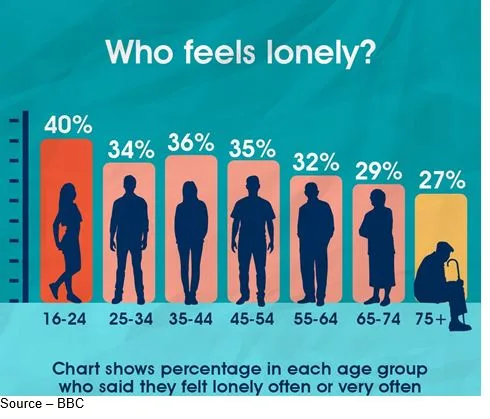
According to Pew Research, that loneliness includes:
- Nearly half of Americans reporting sometimes or always feel alone (46 percent) or left out (47 percent)
- One in four Americans (27 percent) rarely or never feel as though people understand them
- Two in five Americans sometimes or always feel that their relationships are not meaningful (43 percent) and that they are isolated from others (43 percent)
- One in five people report they rarely or never feel close to people (20 percent) or there are people they can talk to (18 percent)
Loneliness leads to:
- Internet addiction disorder (IAD) – continually checking Facebook, Instagram, Twitter, other social networking sites
- Decreased self-esteem – self-conscious, insecure, lack of direct relationships
- Anxiety, depression – added exposure to cyberbullying which multiply the issues
- Making comparisons with other’s lives – comparing yourself with other avid social media users
- Less human contact – regression into social media to avoid face-to-face interaction. Social media friends, followers don’t mean a better social life
- Sleep deprivation, FOMO (fear of missing out) – trading a couple of hours of sleep for social media can affect everything and FOMO only increases stress while decreasing your ability to concentrate on important things
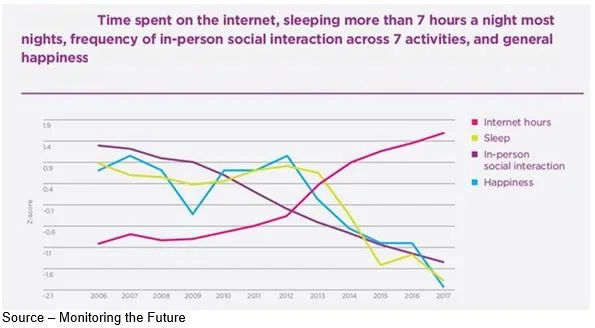
Increasingly, people are wondering when is time spent on social media too much.
During a TED presentation (https://bit.ly/2H3ChL7), Bailey Parnell, one of Canada’s top 100 most powerful women, explored how people’s obsession with social media is actually having a negative impact on their mental health.
In fact, TED (a great way to get lost for days and learn stuff) has had a number of experts speak on the subject in recent years. They’ve all come to the conclusion that social media is the least enjoyable thing you can do alone.
Health practitioners are realizing that this self-imposed separation from real people can lead to mental and physical issues.
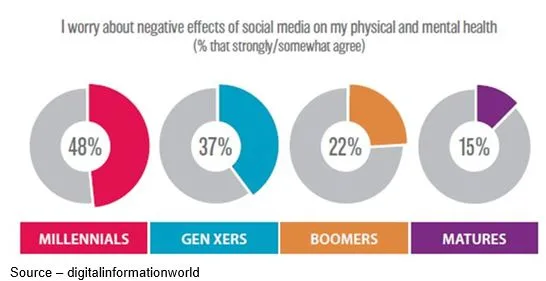
Social isolation is one thing, but excessive social media time can also produce an increased risk of heart disease, stroke and premature death.
Maybe all of those social media folks are more interested in your data than you.
Just saying!
The big problem with social media is that human beings are social creatures.
We thrive in environments that give us opportunities to interact, learn, teach, influence, and be influenced.
Folks atrophy emotionally, intellectually and spiritually when this interaction is limited.
If you were to have an online day with 500 friends on the internet, it probably wouldn’t translate into five friends in real life.
Social media was never meant to be a replacement for personal contact. It was supposed to be an enhancement, extension, a bridge to old and new acquaintances, relationships.
Instead, it further isolates people.
We know you were told as a child to never talk with strangers, but try walking up to them or passing them with a smile on your face and simply say “Hi.”

Some will grunt.
Some will be surprised as hell.
Most will be startled, smile and say “Hi” in return.
These innocent human interactions will have a positive impact on the other person.
More importantly, they will improve your mood and make you feel less alone, less isolated.
Try it!
Communicating face to face and having an honest human exchange, even if only for a few moments, is better than burying your face in your screen consuming content or connecting/liking someone’s post (or getting mad at it)
You’re so much more than your technology and online exchanges.
If you feel lonely and disconnected, you’re far from alone. In our hyper-connected world, lots of folks feel lonely and the more time they spend on online activities vs. offline activities, the lonelier they feel.
One of the reasons is that all you see and read about is all the stuff everyone else is doing while you’re sitting/walking with your face in your screen.
Of course, now that we’re taking advantage of D2C streaming services and the anytime, anywhere, any screen; the problem is getting worse.
There is nothing better than being able to watch the show(s) you want from Netflix, Amazon Prime, Disney + (and add-ons), Apple TV +, Tubi, Pluto TV, Peacock, Paramount+ and … others.
If you were still connected to your cable company’s Pay TV formula, you probably didn’t have a lot to talk about around the office or at the bar with friends.
But with your OTT streaming services, you can quickly catch up by binging all night, so you’re tired but up to speed the next day.
With streaming services, a lot of families find they eliminate the biggest point of friction at home–what to watch this evening.

According to a recent study by Ampere Analysis, there’s been a sudden increase of solo viewers who no longer have to “tolerate” the show dictates of mom and/or dad.
They simply grab their device (computer/tablet/smartphone) and tune in to their own show and catch up on their personal shows.
Of course, you’re lucky if they stay in the same room but usually, they simply retreat to their room to binge out.
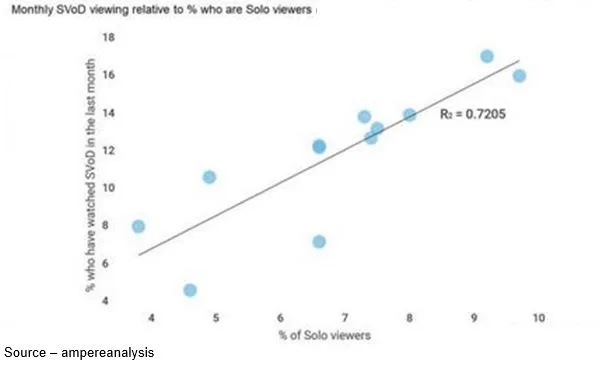
Somehow, we believe this is going to produce a double dose of loneliness in the near future.
Kids who are growing up with a smartphone in their hand (or close by) also have access to all of the other personal screens, including their own TV.
When they aren’t on Instagram, TikTok or something else while going to/coming from school; they’re catching up on some “gotta watch” show.
At least the streaming entertainment gives them a break from social media, so that’s probably a good thing.
When they’re home, they multitask – watch something on their TV or computer/iPad with no FOMO because the smartphone lets them stay in touch while not being in touch.
On the upside, streaming to any screen also eliminates another friction at home – who gets disappointed.
The household stress of compromising on what is watched on the TV screen disappears.
Everyone has his/her own choice of content on their own screen.
Streaming organizations want to attract as many subscribers/viewers as possible, so they offer “something for everyone.”
They’re making it as easy as possible to lose track of what’s going on in your social media locations and become involved in a great movie or show.
How involved?
Good content sucks you in 10X better than social media and it keeps you involved.
No wonder Ampere says the number of solo viewers will continue to rise.
And maybe that’s why Reid Hastings (Netflix CEO) was right when he initially observed that their greatest competition was sleep.
Yeah, he later admitted it was TikTok.
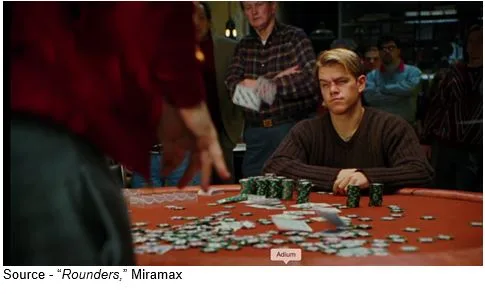 Social media was designed from the outset to keep people hooked on bragging and keeping followers involved so providers can gather more data to deliver targeted ads.
Social media was designed from the outset to keep people hooked on bragging and keeping followers involved so providers can gather more data to deliver targeted ads.
Filmmakers simply want to give you a refreshing break from stuff.
Too much of either one is bad for you; but at least when you wake up from binging on great content, you don’t have regrets.
And as Teddy KGB pointed out, “Respect is all you have left in the morning!”
Probably true but sailing was a heckofa lot more fun.
# # #
Andy Marken – [email protected] – is an author of more than 700 articles on management, marketing, communications, industry trends in media and entertainment, consumer electronics, software and applications. An internationally recognized marketing/communications consultant, he has a broad range of technical and industry expertise–especially in the storage, storage management and film/video production fields. With his experience and expertise., he has developed an extended range of relationships with business, industry trade press, online media and industry analysts/consultants.